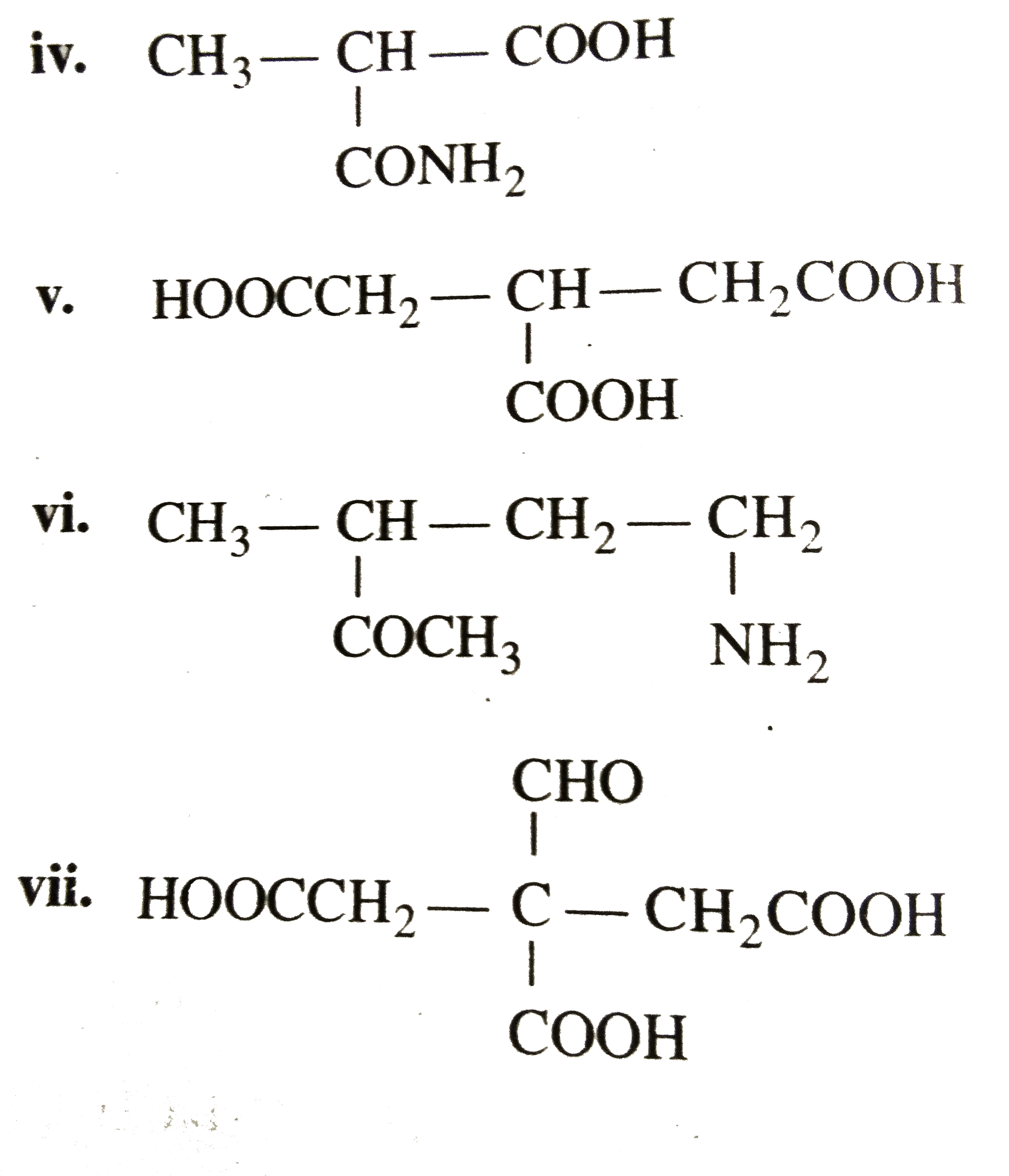CH3−OH∣C∣H−CN is
Acetaldehyde cyanohydrin
Acetone cyanohydrin
Cyanoethanol
Ethanol nitrile
The correct Answer is:A
To solve the problem, we need to analyze the given chemical structure CH₃CHOHCN and identify what it represents.
1. Identify the Structure:
The given structure is CH₃CHOHCN. This can be broken down as follows:
- CH₃- indicates a methyl group.
- CHO- indicates an aldehyde functional group.
- OH- indicates a hydroxyl group.
- CN- indicates a cyano group.
2. Recognize the Functional Groups:
The presence of the aldehyde (CHO) and the cyano group (CN) suggests that this compound is derived from an aldehyde with a cyano group attached. The hydroxyl group (OH) indicates that it could be a hydroxy compound.
3. Determine the Base Structure:
The base structure appears to be acetaldehyde (CH₃CHO), which is a 2-carbon aldehyde.
4. Reaction with Hydrogen Cyanide (HCN):
When acetaldehyde reacts with hydrogen cyanide (HCN), it undergoes a nucleophilic addition reaction. The cyano group (CN) adds to the carbonyl carbon of the aldehyde, forming a cyanohydrin.
5. Formation of the Product:
The product formed from this reaction is known as acetaldehyde cyanohydrin. The structure can be represented as CH₃C(OH)(CN)H, indicating that the hydroxyl (OH) and cyano (CN) groups are attached to the same carbon atom.
6. Conclusion:
Therefore, the compound CH₃CHOHCN is identified as acetaldehyde cyanohydrin.
Final Answer:
The correct answer is Acetaldehyde Cyanohydrin.
The given structure is CH₃CHOHCN. This can be broken down as follows:
- CH₃- indicates a methyl group.
- CHO- indicates an aldehyde functional group.
- OH- indicates a hydroxyl group.
- CN- indicates a cyano group.
The presence of the aldehyde (CHO) and the cyano group (CN) suggests that this compound is derived from an aldehyde with a cyano group attached. The hydroxyl group (OH) indicates that it could be a hydroxy compound.
The base structure appears to be acetaldehyde (CH₃CHO), which is a 2-carbon aldehyde.
When acetaldehyde reacts with hydrogen cyanide (HCN), it undergoes a nucleophilic addition reaction. The cyano group (CN) adds to the carbonyl carbon of the aldehyde, forming a cyanohydrin.
The product formed from this reaction is known as acetaldehyde cyanohydrin. The structure can be represented as CH₃C(OH)(CN)H, indicating that the hydroxyl (OH) and cyano (CN) groups are attached to the same carbon atom.
Therefore, the compound CH₃CHOHCN is identified as acetaldehyde cyanohydrin.
The correct answer is Acetaldehyde Cyanohydrin.
Topper's Solved these Questions
- BOOK - NARAYNACHAPTER - ALDEHYDES, KETONES & CARBOXYLIC ACIDSEXERCISE - EXERCISE -I (C.W.)15videos
ALDEHYDES, KETONES & CARBOXYLIC ACIDS
- BOOK - NARAYNACHAPTER - ALDEHYDES, KETONES & CARBOXYLIC ACIDSEXERCISE - EXERCISE -I (H.W.)15videos
ALDEHYDES, KETONES & CARBOXYLIC ACIDS
- BOOK - NARAYNACHAPTER - ALDEHYDES, KETONES & CARBOXYLIC ACIDSEXERCISE - EVALUATE YOURSELF -58videos
ALDEHYDES, KETONES & CARBOXYLIC ACIDS
- BOOK - NARAYNACHAPTER - ALCOHOLS, ETHERS, PHENOLEXERCISE - Assertion Reaosn10videos
ALCOHOLS, ETHERS, PHENOL
- BOOK - NARAYNACHAPTER - AMINES & DIAZO COMPOUNDSEXERCISE - Subjective type Q.13videos
AMINES & DIAZO COMPOUNDS
Similar Questions
Give the IUPAC names for the following polyfunctional compounds:
i. CH3CH2O−CH2−CHOH−CH3
ii. CH3−uNO2ndereset(∣)(C)N−CH2−CH3∣C∣OH−CH3
iii. CH2=H3C∣C−OH∣CH−CH2CN
 View Solution
View SolutionCompare rate of reaction towards pinacol pinacolone rearrangement.
Ph−CH3∣C∣OH−CH3∣C∣OH−Ph(I) CH3−CH3∣C∣OH−Ph∣C∣OH−Ph(II) CH3−CH3∣C∣OH−CH3∣C∣OH−CH3(III)View Solution
Knowledge Check
- Question 1 - Select One
The IUPAC name for
CH3−CH∣OH−CH2−CH3∣C∣OH−CH3 is:A1, 1-Dimethylbutane -1, 3-diolB4-Methylpentane-2, 4-diolC2-Methylpentane-2, 4-diolD1, 3, 3-Trimethylpropane-1, 3-diol - Question 2 - Select One
The IUPAC name of the compound
H3C−CH2−C∣∣CH2−CH2−OH∣C∣NH2−CH3 isA2-Amino- 4- ethyl -2 - hydroxypent - 4 - eneB2-Amino - 4 - ethylpent - 4 - en - 2 - olC4-Ethyl - 2 - hydroxypent - 4 -en - 2 - amineD2-Amino - 4 - methylhexan - 2 -ol - Question 3 - Select One
Ph−CH3∣C∣OH−Ph∣C∣OH−PhConc−−−→H2SO4 Product is
APh−CH3∣C∣OH−Ph∣C∣OH−CH3BPh−C∣∣O−C∣∣O−PhCCH3−C∣∣O−Ph∣C∣Ph−CH3DPh−C∣∣O−C∣∣O−CH3
AH2/Raney Ni−−−−−−−→CH3−CH2−H∣C∣H−OH. A is ___________.
View SolutionThe major product formed in the reaction is:
CH3−CH3∣C∣H−CH2BrCH3OӨ−−−−→CH3OHView SolutionThe IUPAC name of CH3−C∣OHH−CH2−CH3∣−∣OHCH3 is
View SolutionThe IUPAC name of
CH3−CH∣OH−CH2−CH2−CH2−Br∣C∣Br−CH3View SolutionThe conversation :
CH3−CH3∣C∣OH−CH3∣C∣OH−CH3dil−−−→H2SO4CH3−CH3∣C∣CH3−C∣∣O−CH3
is called :View Solution

